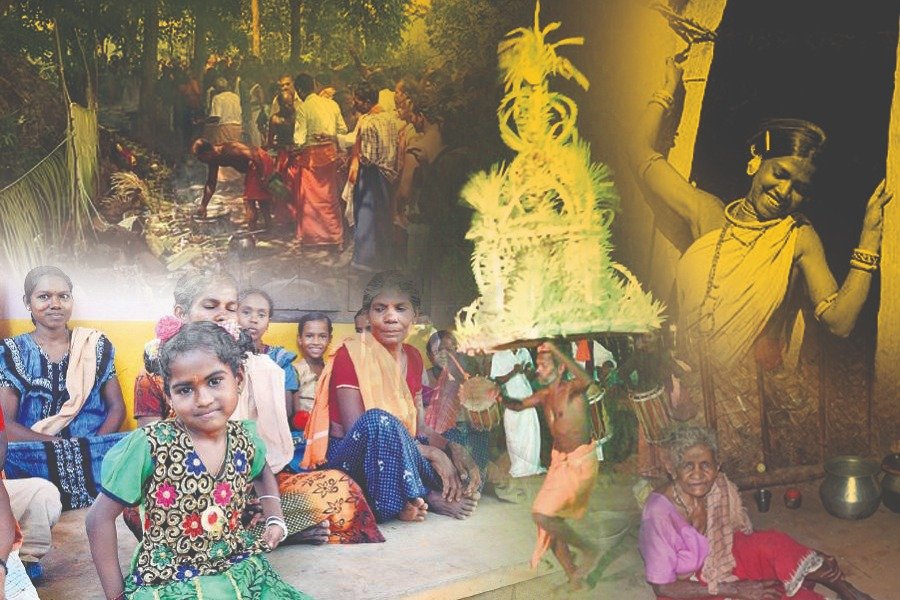Read in : தமிழ்
Kani tribes learned many skills by keenly observing nature. Ants and dragonflies in forests were their teachers. Those skills got expression in their art, customs and traditions. But the march of modernity has disrupted the lives of Kanis. Their art forms have nearly vanished.
The customs and traditions of Kani tribes who live in the Western Ghats are unique. They are full of songs and dances. Kanis had songs for birth, good wishes, stories, rain, irrigation and so on. They knew how to serve up the environment and climate as art.
Dance was a key part of all their rituals. Their proverbs were teachings . Their puzzles untangled life’s problems.
The girl who came of age was referred to as someone who has gathered herself up. A girl who reaches puberty would stay in a big tent on farmland for seven days. During those seven days, tribesfolk would sing a song called Theralipattu when they would take her to the bath. The song would tell the girl about all the changes that would happen to her body.
Before weddings, Kanis would sing a song celebrating the acceptance of the marriage proposal. Art was used to express the marriage proposal.
Dance was a key part of all their rituals. Kani proverbs were teachings . Their puzzles untangled life’s problems.
During marriage, friends and relatives would sing a congratulatory song, Vazhthu Padal. The couple, who were stepping into a new phase in their lives, would be told about life’s conventions and rules through a story expressed in song.
If someone became ill, Kanis would sing a mantra song. They had separate mantra songs each for gathering forest products, fishing, farming as well as hunting. The songs would express the nuances of these activities.
Teaching was done through doing in the Kani tribe. Nature was the classroom. The songs helped to keep the knowledge alive so it could be passed on to the next generation.
If someone in the tribe died, his life would be summed up by an Appearance song, Thotra Padal. His contributions to society would be recalled in that song which would offer consolation to the family.
In Kani tribes, the elderly are called Pilathu Kani – medicine men. The tribal doctor would sit in front of the afflicted on a Thumbai (Leucas Aspera) leaf. He would spread fruits, betel leaves and nuts, and sit in front of it and make a prayer. He would chant some mantras. The belief was that spirits would then enter the Pilathu Kani’s body and help him cure the sick man. Today, Kani tribes go to hospitals if they become sick. The rituals are no more conducted.
Raingathering Song, Mazhaithirattu Padal, was sung for traditional agriculture. To boost their farm yield, the Kani tribes would sing Satrupadal, praying to mountain deities. When singing the song, they would blow on the Kokkarai, a traditional wind instrument. Kani tribes believe they learned to play this instrument from Saint Agathiyar in the Podhigai Hills.
Kanis use the Tamil word for hop, Thullal, to denote dance. Their dance movements were close to nature.
During cultural events, the males would get together on one side and sing as a group and females would get together on the other side. The person sitting in the middle would jump like a dragonfly and sing.
In the nights, women would get together and sing the Sonan song. Sonan is a forest ant. The belief is that the Sonan spirit would get into a woman’s body and make her move like the ant.
Kanis use the Tamil word for hop, Thullal, to denote dance. Their dance movements were close to nature.
Kanis believed that the spirits of demons who lived in the past brought good tidings. For that to happen, they had a Ghost Dance, Peyan Thullal. The tribesman who assumed the character of the ghost, Peyan, would roll all around on the ground and raise a cry. Typically women would perform the Ghost Dance.
Kali Thullal was another dance. Kali stands for god. Kanis would blow the conch, beat the Parai drum and dance to please god. The dance would bring to mind the trees and plants in the forest.
Kanis connected dancing to the spirit world. Dance was entertainment as well as sport.
In the month of Karthigai, Kanis would go to houses and sing the Pasanai Pattu. This was believed to ward off diseases.
In Tree Peeling (Mara Uri) dance, Kani men and women would wear the bark of trees as clothes and danced. This dance form showed their closeness to nature and their ancient origins. Kanis would also dance with bows and arrows or with sticks that they would tap in rhythm. All these are going out of practice.
At Uraparai near Pechiparai in Kanyakumari, Satrupadal is performed at the Sastha temple. At Pathukani and Arukanu, during Onam festival, Dragonfly Dance (Thumbi Thullal) is performed. Besides these, other art forms have vanished.
Forest Acts have changed the lives of Kani tribes. The knowledge they gained from nature is being lost. If their knowledge and art are recorded, it may be useful in future. Humanities departments in universities need to do this.
Read in : தமிழ்











